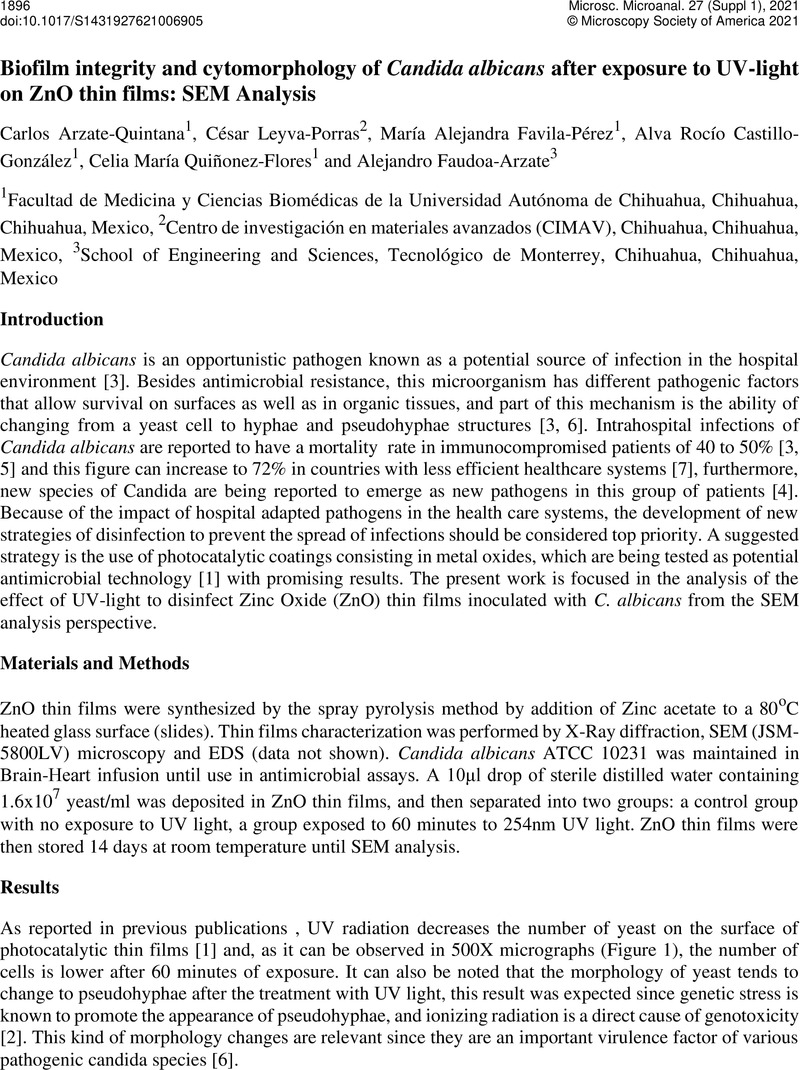No CrossRef data available.
Article contents
Biofilm integrity and cytomorphology of Candida albicans after exposure to UV-light on ZnO thin films: SEM Analysis
Published online by Cambridge University Press: 30 July 2021
Abstract
An abstract is not available for this content so a preview has been provided. As you have access to this content, a full PDF is available via the ‘Save PDF’ action button.

- Type
- Challenges and Advances in Electron Microscopy Research and Diagnosis of Diseases in Humans, Plants and Animals (FIG associated)
- Information
- Copyright
- Copyright © The Author(s), 2021. Published by Cambridge University Press on behalf of the Microscopy Society of America
References
Arzate-Quintana, C, Camarillo-Cisneros, J, Realyvazquez-Guevara, P, Faudoa-Arzate, A, & Rodríguez, H. 2020. SEM Study of the Photocatalytic Activity of SnO2 Films Exposed to UV Radiation Against the Human Pathogen C. albicans. Microscopy and Microanalysis, Vol. 26(S2), pp. 1362-1365. doi:10.1017/S1431927620017845.CrossRefGoogle Scholar
Ruiz G, Bravo, Ross, ZK, Gow, NAR, Lorenz, A. 2020. Pseudohyphal growth of the emerging pathogen Candida auris is triggered by genotoxic stress through the S phase checkpoint. mSphere Vol 5:e00151-20, pp 1-17. https://doi.org/10.1128/mSphere.00151-20.Google Scholar
Chen, H, Zhou, X, Ren, B & Cheng, L. (2020). The regulation of hyphae growth in Candida albicans. Virulence, Vol. 11:1, pp. 337-348, doi: 10.1080/21505594.2020.1748930.CrossRefGoogle ScholarPubMed
Fakhim, H, Vaezi, A, Dannaoui, E, Chowdhary, A, Nasiry, D, Faeli, L, Meis, JF & Badali, H. Comparative virulence of Candida auris with Candida haemulonii, Candida glabrata and Candida albicans in a murine model. Mycoses, Vol. 61: pp. 377–382. doi: 10.1111/myc.12754.CrossRefGoogle Scholar
Kornitzer, D. 2019. Regulation of Candida albicans Hyphal Morphogenesis by Endogenous Signals. J. Fungi, Vol. 5, 21; doi:10.3390/jof5010021.Google ScholarPubMed
Mukaremera, L, Lee, KK, Mora-Montes, HM & Gow, NAR. 2017. Candida albicans Yeast, Pseudohyphal, and Hyphal Morphogenesis Differentially Affects Immune Recognition. Front. Immunol. Vol. 8, pp 629. https://doi.org/10.3389/fimmu.2017.00629.Google ScholarPubMed
Sharma, J, Rosiana, S, Razzaq, I & Shapiro, RS. 2019. Linking Cellular Morphogenesis with Antifungal Treatment and Susceptibility in Candida Pathogens. J. Fungi, Vol. 5, 17; doi:10.3390/jof5010017.Google ScholarPubMed



